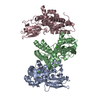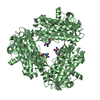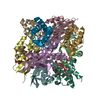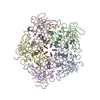[English] 日本語
 Yorodumi
Yorodumi- PDB-2cbl: N-TERMINAL DOMAIN OF CBL IN COMPLEX WITH ITS BINDING SITE ON ZAP-70 -
+ Open data
Open data
- Basic information
Basic information
| Entry | Database: PDB / ID: 2cbl | |||||||||
|---|---|---|---|---|---|---|---|---|---|---|
| Title | N-TERMINAL DOMAIN OF CBL IN COMPLEX WITH ITS BINDING SITE ON ZAP-70 | |||||||||
 Components Components |
| |||||||||
 Keywords Keywords | COMPLEX (PROTO-ONCOGENE/PEPTIDE) / PROTO-ONCOGENE / SIGNAL TRANSDUCTION / PHOSPHOTYROSINE BINDING / SH2 / COMPLEX (PROTO-ONCOGENE-PEPTIDE) / COMPLEX (PROTO-ONCOGENE-PEPTIDE) complex | |||||||||
| Function / homology |  Function and homology information Function and homology informationT cell aggregation / regulation of platelet-derived growth factor receptor-alpha signaling pathway / ubiquitin-dependent endocytosis / regulation of Rap protein signal transduction / positive regulation of alpha-beta T cell proliferation / negative thymic T cell selection / flotillin complex / phosphatidylinositol 3-kinase regulatory subunit binding / beta selection / positive thymic T cell selection ...T cell aggregation / regulation of platelet-derived growth factor receptor-alpha signaling pathway / ubiquitin-dependent endocytosis / regulation of Rap protein signal transduction / positive regulation of alpha-beta T cell proliferation / negative thymic T cell selection / flotillin complex / phosphatidylinositol 3-kinase regulatory subunit binding / beta selection / positive thymic T cell selection / positive regulation of alpha-beta T cell differentiation / Regulation of KIT signaling / positive regulation of epidermal growth factor receptor signaling pathway / positive regulation of T cell differentiation / Interleukin-6 signaling / mast cell degranulation / T cell receptor complex / response to starvation / response to testosterone / Translocation of ZAP-70 to Immunological synapse / negative regulation of epidermal growth factor receptor signaling pathway / B cell activation / TGF-beta receptor signaling activates SMADs / Generation of second messenger molecules / RHOH GTPase cycle / T cell differentiation / immunological synapse / protein monoubiquitination / protein autoubiquitination / Nuclear events stimulated by ALK signaling in cancer / ephrin receptor binding / T cell migration / cellular response to platelet-derived growth factor stimulus / phosphotyrosine residue binding / FLT3 signaling by CBL mutants / Negative regulation of FLT3 / PTK6 Regulates RTKs and Their Effectors AKT1 and DOK1 / positive regulation of calcium-mediated signaling / peptidyl-tyrosine phosphorylation / T cell activation / InlB-mediated entry of Listeria monocytogenes into host cell / response to activity / response to gamma radiation / non-membrane spanning protein tyrosine kinase activity / Regulation of signaling by CBL / Negative regulation of FGFR3 signaling / non-specific protein-tyrosine kinase / Negative regulation of FGFR2 signaling / Negative regulation of FGFR4 signaling / Negative regulation of FGFR1 signaling / EGFR downregulation / calcium-mediated signaling / Spry regulation of FGF signaling / Negative regulation of MET activity / Constitutive Signaling by EGFRvIII / cellular response to nerve growth factor stimulus / receptor tyrosine kinase binding / RING-type E3 ubiquitin transferase / positive regulation of receptor-mediated endocytosis / SH3 domain binding / male gonad development / protein polyubiquitination / cytokine-mediated signaling pathway / Signaling by CSF1 (M-CSF) in myeloid cells / ubiquitin-protein transferase activity / ubiquitin protein ligase activity / cell-cell junction / Cargo recognition for clathrin-mediated endocytosis / T cell receptor signaling pathway / Constitutive Signaling by Ligand-Responsive EGFR Cancer Variants / Clathrin-mediated endocytosis / growth cone / protein tyrosine kinase activity / ubiquitin-dependent protein catabolic process / response to ethanol / cellular response to hypoxia / adaptive immune response / protein phosphorylation / positive regulation of phosphatidylinositol 3-kinase/protein kinase B signal transduction / intracellular signal transduction / immune response / protein ubiquitination / cilium / cadherin binding / membrane raft / focal adhesion / calcium ion binding / DNA damage response / symbiont entry into host cell / negative regulation of apoptotic process / perinuclear region of cytoplasm / Golgi apparatus / signal transduction / zinc ion binding / ATP binding / plasma membrane / cytoplasm / cytosol Similarity search - Function | |||||||||
| Biological species |  Homo sapiens (human) Homo sapiens (human) | |||||||||
| Method |  X-RAY DIFFRACTION / X-RAY DIFFRACTION /  SYNCHROTRON / SYNCHROTRON /  MOLECULAR REPLACEMENT / Resolution: 2.1 Å MOLECULAR REPLACEMENT / Resolution: 2.1 Å | |||||||||
 Authors Authors | Meng, W. / Sawasdikosol, S. / Burakoff, S.J. / Eck, M.J. | |||||||||
 Citation Citation |  Journal: Nature / Year: 1999 Journal: Nature / Year: 1999Title: Structure of the amino-terminal domain of Cbl complexed to its binding site on ZAP-70 kinase. Authors: Meng, W. / Sawasdikosol, S. / Burakoff, S.J. / Eck, M.J. | |||||||||
| History |
|
- Structure visualization
Structure visualization
| Structure viewer | Molecule:  Molmil Molmil Jmol/JSmol Jmol/JSmol |
|---|
- Downloads & links
Downloads & links
- Download
Download
| PDBx/mmCIF format |  2cbl.cif.gz 2cbl.cif.gz | 87.6 KB | Display |  PDBx/mmCIF format PDBx/mmCIF format |
|---|---|---|---|---|
| PDB format |  pdb2cbl.ent.gz pdb2cbl.ent.gz | 63.9 KB | Display |  PDB format PDB format |
| PDBx/mmJSON format |  2cbl.json.gz 2cbl.json.gz | Tree view |  PDBx/mmJSON format PDBx/mmJSON format | |
| Others |  Other downloads Other downloads |
-Validation report
| Summary document |  2cbl_validation.pdf.gz 2cbl_validation.pdf.gz | 448.5 KB | Display |  wwPDB validaton report wwPDB validaton report |
|---|---|---|---|---|
| Full document |  2cbl_full_validation.pdf.gz 2cbl_full_validation.pdf.gz | 464.5 KB | Display | |
| Data in XML |  2cbl_validation.xml.gz 2cbl_validation.xml.gz | 22.3 KB | Display | |
| Data in CIF |  2cbl_validation.cif.gz 2cbl_validation.cif.gz | 31.2 KB | Display | |
| Arichive directory |  https://data.pdbj.org/pub/pdb/validation_reports/cb/2cbl https://data.pdbj.org/pub/pdb/validation_reports/cb/2cbl ftp://data.pdbj.org/pub/pdb/validation_reports/cb/2cbl ftp://data.pdbj.org/pub/pdb/validation_reports/cb/2cbl | HTTPS FTP |
-Related structure data
- Links
Links
- Assembly
Assembly
| Deposited unit | 
| ||||||||
|---|---|---|---|---|---|---|---|---|---|
| 1 | 
| ||||||||
| Unit cell |
| ||||||||
| Components on special symmetry positions |
|
- Components
Components
| #1: Protein | Mass: 35429.961 Da / Num. of mol.: 1 / Fragment: DOMAIN Source method: isolated from a genetically manipulated source Source: (gene. exp.)  Homo sapiens (human) / Production host: Homo sapiens (human) / Production host:  |
|---|---|
| #2: Protein/peptide | Mass: 1344.275 Da / Num. of mol.: 1 / Fragment: BINDING SITE FRAGMENT Source method: isolated from a genetically manipulated source References: UniProt: P43403*PLUS |
| #3: Chemical | ChemComp-CA / |
| #4: Water | ChemComp-HOH / |
| Has protein modification | Y |
-Experimental details
-Experiment
| Experiment | Method:  X-RAY DIFFRACTION / Number of used crystals: 1 X-RAY DIFFRACTION / Number of used crystals: 1 |
|---|
- Sample preparation
Sample preparation
| Crystal | Density Matthews: 3.18 Å3/Da / Density % sol: 61 % | |||||||||||||||||||||||||
|---|---|---|---|---|---|---|---|---|---|---|---|---|---|---|---|---|---|---|---|---|---|---|---|---|---|---|
| Crystal grow | pH: 6.1 / Details: pH 6.1 | |||||||||||||||||||||||||
| Crystal | *PLUS | |||||||||||||||||||||||||
| Crystal grow | *PLUS Temperature: 22 ℃ / Method: vapor diffusion, hanging drop | |||||||||||||||||||||||||
| Components of the solutions | *PLUS
|
-Data collection
| Diffraction | Mean temperature: 100 K |
|---|---|
| Diffraction source | Source:  SYNCHROTRON / Site: SYNCHROTRON / Site:  CHESS CHESS  / Beamline: F1 / Wavelength: 0.918 / Beamline: F1 / Wavelength: 0.918 |
| Detector | Type: MARRESEARCH / Detector: CCD / Date: May 1, 1998 |
| Radiation | Monochromatic (M) / Laue (L): M / Scattering type: x-ray |
| Radiation wavelength | Wavelength: 0.918 Å / Relative weight: 1 |
| Reflection | Resolution: 2.1→99 Å / Num. obs: 20620 / % possible obs: 76.9 % / Redundancy: 1.74 % / Rmerge(I) obs: 0.079 / Net I/σ(I): 8.3 |
| Reflection shell | Resolution: 2.1→2.16 Å / Redundancy: 1 % / Rmerge(I) obs: 0.023 / Mean I/σ(I) obs: 1.5 / % possible all: 42.3 |
| Reflection | *PLUS Num. measured all: 35952 |
- Processing
Processing
| Software |
| ||||||||||||||||||||||||||||||||||||||||||||||||||||||||||||
|---|---|---|---|---|---|---|---|---|---|---|---|---|---|---|---|---|---|---|---|---|---|---|---|---|---|---|---|---|---|---|---|---|---|---|---|---|---|---|---|---|---|---|---|---|---|---|---|---|---|---|---|---|---|---|---|---|---|---|---|---|---|
| Refinement | Method to determine structure:  MOLECULAR REPLACEMENT MOLECULAR REPLACEMENTStarting model: CBL-N Resolution: 2.1→20 Å / Cross valid method: THROUGHOUT / σ(F): 2.1
| ||||||||||||||||||||||||||||||||||||||||||||||||||||||||||||
| Refinement step | Cycle: LAST / Resolution: 2.1→20 Å
| ||||||||||||||||||||||||||||||||||||||||||||||||||||||||||||
| Refine LS restraints |
|
 Movie
Movie Controller
Controller











 PDBj
PDBj

















